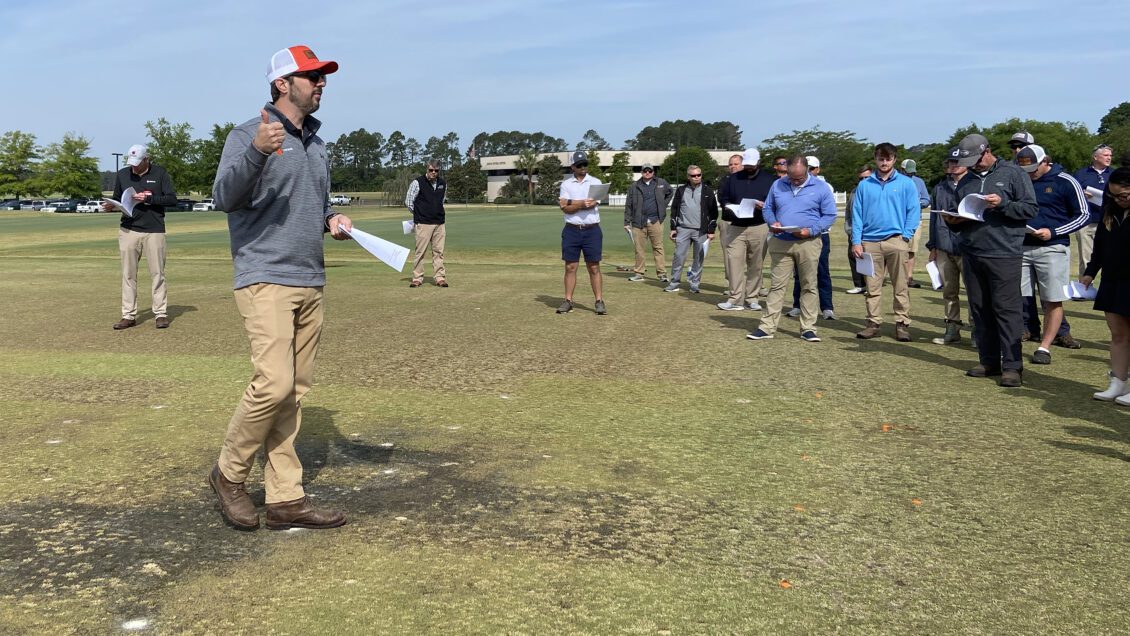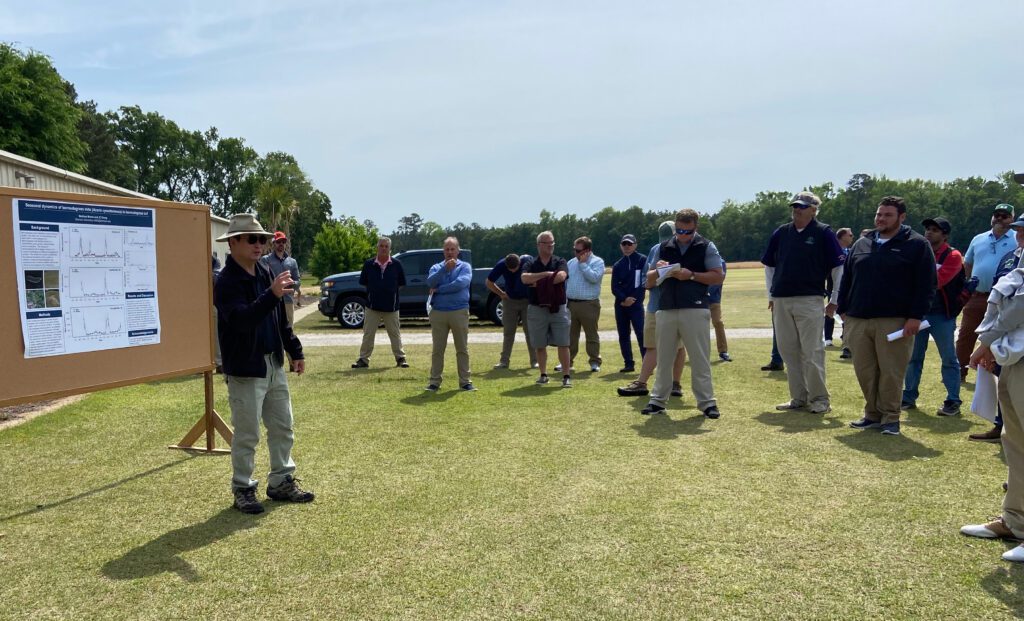
Turfgrass is an integral part of both golf courses and landscapes, and Clemson University experts are helping golf course superintendents and homeowners learn how to grow turfgrass to best meet their needs.
The latest research-based information on turfgrass was shared with about 130 people who attended the annual Clemson University Turfgrass Research Field Day at the Pee Dee Research and Education Center (REC) near Florence, South Carolina, where they learned how to control diseases, insects, weeds and other pests.
Clemson turfgrass specialist Bert McCarty talked about controlling Poa annua, or Poa, an annual bluegrass that has become resistant to many herbicides.
“Poa annua is a troublesome weed in turfgrass and other landscapes,” McCarty said. “When going after Poa annua, you need to incorporate products with multiple modes of action.”
When herbicides are used, McCarty advises diversifying sites of action between years and within seasons. Repeated use of herbicides with the same site of action can cause herbicide resistance.
“Rotate, rotate, rotate to prevent herbicide resistance,” McCarty said. “I cannot stress how important it is to rotate. When herbicides are used, diversify sites of action between years and within seasons.”
Growers should use labeled rates at appropriate timings and stages of growth when applying herbicides to turfgrass.
McCarty is part of a nationwide list of experts who are focused on limiting the impacts of Poa annua. A website, www.resistpoa.org, contains information related to Poa annua studies from university researchers in 15 states. In addition, videos featuring McCarty addressing several areas of Poa annua, or annual bluegrass, control can be found on YouTube at https://www.youtube.com/@DrBertMcCarty.

Controlling bermudagrass mites in turf
In addition to weeds, insect pests can also create problems for bermudagrass turf and hay. Bermudagrass mites can distort growth, cause poor stem and root development, and even cause death in bermudagrass.
“Heavy infestations cause large bare spots in turf, which ruins turf aesthetics and playing surface, as well as allows weeds to easily invade,” said J.C. Chong, Clemson adjunct professor. “On sod farms, mite infestations reduce growth and ruin sod quality.”
Mite infestations cause shortened internodes, stunted leaves, swollen stems and tiller proliferation from the infested nodes. These symptoms resemble brooms and are called “witches’ brooms.” Chong and other researchers conducted a study to determine the seasonal dynamics of witches’ brooms and bermudagrass mite populations.
“We’ve identified a crucial period during spring and early summer when the number of witches’ brooms and bermudagrass mite populations tend to increase,” Chong said. “The number of witches’ brooms and bermudagrass mite populations showed similar responses to weather variables such as wind speed, rainfall and relative humidity.”
Bermudagrass mite infestations are often associated with stressed turf, especially drought-stressed turf. Irrigation reduces the number of mite-infested shoots. Cultural controls include lowering mowing height, or scalping. If scalping is used, Chong said clippings must be collected and discarded to avoid spreading any mites.
Miticides are often used for chemical control to manage bermudagrass mites but provide inconsistent control.

Biochar and compost for nematode control
Sting nematodes are among the most damaging of all plant-parasitic nematodes. Because of their high sand content, most golf course greens are ideal habitats for sting nematodes. Researchers have found applying biochar as a top dressing can improve turfgrass quality in areas with high populations of sting nematodes.
“Biochar applied as a topdressing at a rate of 10 pounds per 1,000 ft2 or biochar combined with compost applied at 20 pounds per 1,000 ft2 in turfgrass with high sting nematode populations improved turfgrass quality,” said Joseph Roberts, turfgrass pathologist and nematology Clemson Cooperative Extension Service specialist. “Nematode populations were not impacted through these topdressings.”
Biochar is an organic carbon-rich product that can be used as a soil amendment to sequester carbon, as well as reduce soil compaction, increase drainage in soils, improve soil structure and more. It is a charcoal produced by burning organic material in a low-oxygen environment, or a process known as “pyrolysis” or “charring.” This converts the carbon to a form that resists decay and can remain in the soil for centuries.
The study consisted of using biochar alone and biochar combined with compost in a product called CarbonizPN.
Plans for future studies include incorporating biochar and biochar-compost material in the root zone to determine if biochar can reduce nematode populations. Researchers also are interested in additional biochar products produced from different organic materials.
In addition to this information, participants also learned about fungicide and nematicide programming for year around bermudagrass putting green performance and fungicides for reducing the pathogen large patch in zoysiagrass.
-END-
Get in touch and we will connect you with the author or another expert.
Or email us at news@clemson.edu
